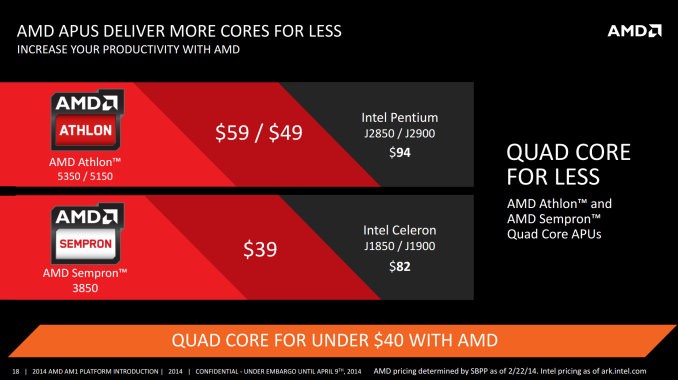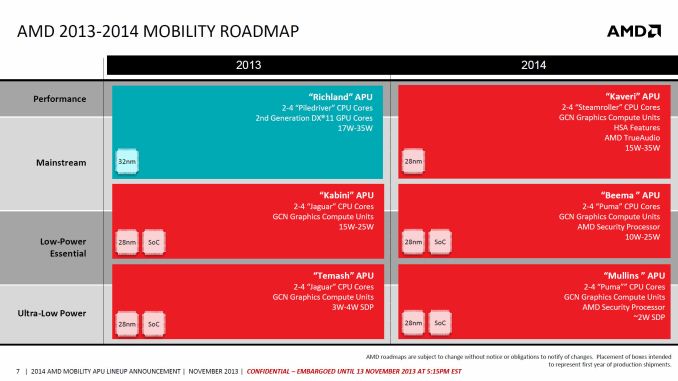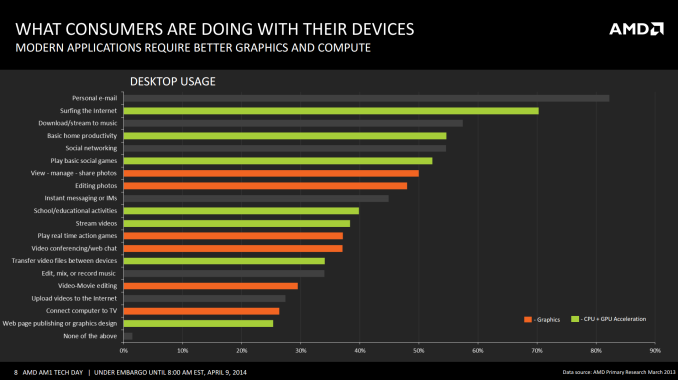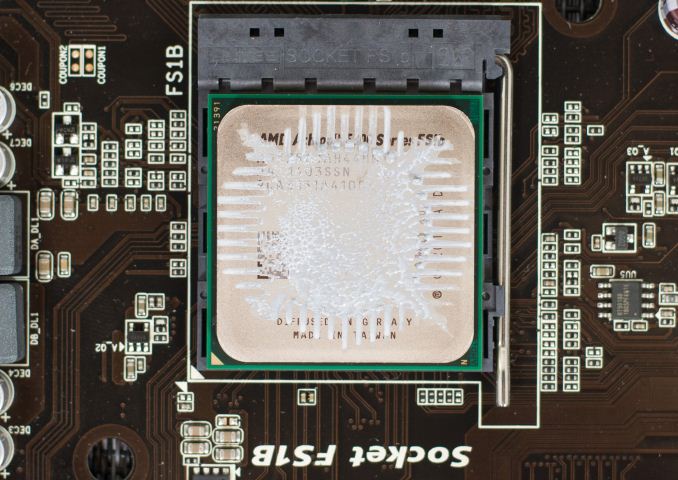The Desktop Kabini Review Part 1: AMD Athlon 5350 (AM1) Tested
by Ian Cutress on April 9, 2014 8:00 AM ESTFinal Words
As mentioned in our test setup, the benchmark results in this preliminary article are only a small fraction of our normal coverage. Due to other commitments we were unable to run every test on all comparison systems, but we have the other Athlon and Sempron APUs as well as comparable Intel counterparts coming in for review.
The poignant place to start with the final analysis is AMD’s claim of ‘Quad Core for Less’. In this statement alone, they are not wrong. Intel cannot provide a socketed quad core processor for less than $36 (Sempron 3850). The cheapest all-in-one desktop quad-core system from Intel equips the Celeron J1900 onto a motherboard for $92, which is exactly where AMD sit with the top-end Kabini based Athlon 5350 with a motherboard. One of the issues to consider at this point however is that Intel offers several dual core options (non-Atom) around this $40-$60 price point, and in many cases the IPC and CPU speed advantage of these cores is greater than that provided by Kabini, particularly in single threaded applications. The only downsides to this solution are the power consumption is higher, and the motherboards are more expensive. For a competitive socketed Intel dual core, a motherboard plus CPU can be in the region of $110-$120 at 35W-55W.
The big upside and selling point from the AM1 Kabini platform should be upgradeability. If a user buys an AM1 platform now, they should be able to upgrade it in the future. While AMD has not yet confirmed if Beema is coming to the socketed platform, the roadmaps suggest that the laptop sockets are remaining consistent from Kabini to Beema. This should imply that if Beema gets a socketed version, it should also remain based on AM1/FS1b.
If we compare single threaded performance between Kabini and our J1800 test system, the benchmarks are almost even between the two, particularly when it comes to synthetics such as Cinebench, but falls behind on emulation such as the Dolphin Benchmark and 3DPM. The integrated graphics of the Kabini pull ahead when it comes to gaming, despite the single channel memory interface.
|
AMD Athlon 5350 vs. Intel Celeron J1800 Single Threaded |
||
| Athlon 5350 | Celeron J1800 | |
| Cinebench R10 | 1967 | 1917 |
| Cinebench R11.5 | 0.51 | 0.49 |
| Dolphin Benchmark | 40.4 | 38.02 |
| 3DPM | 53.29 | 69.20 |
When placing Kabini against any Intel Ivy Bridge socketed processor, the increased IPC and frequency pushes the system above the Kabini, in exchange for more power and a more expensive system overall. If we compare the Kabini single-threaded results to those of the Celeron G465, a Sandy Bridge based single core CPU at 1.9 GHz, the Celeron does pull ahead on the majority, but fails miserably in the graphical benchmark suite.
|
AMD Athlon 5350 vs. Intel Celeron G465 Single Threaded |
||
| Athlon 5350 | Celeron G465 | |
| Cinebench R10 | 1967 | 2975 |
| Cinebench R11.5 | 0.51 | 0.73 |
| Dolphin Benchmark | 40.4 | 38.8 |
| 3DPM | 53.29 | 59.98 |
Does it seem particularly odd that a modern Kabini architecture at 2 GHz cannot keep up with a 3 year old Sandy Bridge processor at 1.9 GHz at our simple benchmarks? AMD is leveraging on the fact that much of what we do on a computer as a casual user can leverage the fixed function units of the graphics center of the APU:
AMD’s key in all of this is leveraging the GPU. For non-GPU intensive tasks, on paper, the J1900 for $92 and 10W TDP would seem to be the choice if upgradability is not a concern. The remit of AM1 and Kabini could be extended if motherboard manufacturers decided to use those extra PCIe lanes. Consider an AM1 with controllers to make a nice routing system (4x NIC) or something based around storage (SATA controllers and hubs). But because Kabini is also a cost play for AMD at the low-end desktop segment, margins are going to be ultra-tight for motherboard manufacturers and I do not imagine that as much effort will be put into making innovative products as the rest of their product range on other sockets.
In order for the upgradability angle to work, AMD need to keep the sockets around for at least two generations. AM1 comes late in Kabini’s life cycle, given that Beema on the mobile side is due out later in 2014. It would make sense for AMD to release Beema desktop parts, but the big question there is when. AMD could launch new processors on day 1 of Beema, or further into the life cycle. I would imagine that depends on what the competition does. AMD does have that advantage of having an upgradeable platform before Intel; however Intel may see the market differently. It is a hard one to judge.
Stay tuned for our full benchmark suite on the other AMD Kabini APUs.














126 Comments
View All Comments
azazel1024 - Thursday, April 10, 2014 - link
Dear gods yes. Taking DC-DC from a laptop power brick would be awesome. Heck, especially the Intel systems are probably looking at 40-50w absolute max, even with a drive or two in there.Considering there are many 90w power bricks...seems like it could take 12v in no problems.
For the commenter who posted the Tom's review on power numbers who seems to be indicating little difference in power consumption...that 3.5w figure, looking at TOTAL PACKAGE power consumption, is greater than a 10% difference at idle and the figures under load are more like a 30-40% difference in power consumption.
Since I assume the board and other bits add a fair amount here, the CPU difference is looking like probably double the CPU idle power consumption and triple the CPU load power consumption for the Kabini versus Bay Trail.
Also, the power consumption figures on both systems are crap. My full up mATX G1610 uses less power at idle and under load than the Kabini system uses and mine even uses less power than the Bay Trail based one at idle. So either the boards and devices attached are total crap, or else they are using one huge and power inefficient PSU to test with. Heck, mine isn't even all that great, a 380w Antec Earth watts bronze rated. Something like a 360w Seasonic gold would probably drop my idle power under 20w from the 21w it is now and load to under 45w.
So my guess is a big, power inefficient PSU, at the least and maybe just crappy component selection too.
No matter what though, Kabini doesn't look good there, in comparison to Bay Trail or in comparison to an Intel "55w TDP" processor either...which has oodles more CPU performance.
mikato - Friday, April 11, 2014 - link
I agree, the PSU is really important here. A big PSU will be inefficient for a low power system even if it's a 80 PLUS Gold or something.ruthan - Thursday, April 10, 2014 - link
Simply slug, this HW is already dead.25W is too much for netbook or tablet, and for NAS or HTPC are Corei3 much better choice. GPU performance is also worse that IntelHD4000.
azazel1024 - Thursday, April 10, 2014 - link
I am tossing around the idea of a core i3 for my next server depending on exactly what Cherry/Willow Trail and Broadwell/Skylake might hold.The extra cost might be worth it for, what might be, significantly better performance at not significantly higher power consumption during "normal work" which is idle or streaming.
Otherwise, back to a Broadwell/Skylake based entry level celeron probably. The price and performance are hard to beat for the kind of basic server that I need.
Samus - Thursday, April 10, 2014 - link
Wow that's actually really fast for a 25w CPU. I mean A6-5200 isn't no slouch and its right on par with it.beesbees - Thursday, April 10, 2014 - link
My good ole AMD Athlon dual core at 3GHZ and 7790 oc 2GB with 4GB DDR2 plays all games maxed. I spent like $60 on that CPU on Newegg back in 2009! Who needs 4 cores? lolHangFire - Friday, April 11, 2014 - link
Moshi Monsters is great stuff, isn't it?abufrejoval - Thursday, April 10, 2014 - link
Here in Germany the J1900 became available before the J1800 at my favorite retailer: I got aGIGABYTE GA-J1900N-D3V (quad core) some weeks ago, put it into a mini-ITX case with a 90Watt PicoPSU (needed the 12V 4pin connector) and a 60Watt 12V notebook power supply.
Added a Crucial C300 for storage and went ahead testing with Window 8.1 (the only thing that worked with the initial BIOS) and then with Win7, CentOS 6.5, Fedora 20, Android x86 after the new BIOS made that possible.
Did the same with a GIGABYTE GA-J1800N-D2H (dual core) two weeks later and benched them side by side.
Main attraction was of course the fully passive cooling design and the main question was whether they would qualify as a credible desktop for office work or low power server.
First off, both CPUs *always* work at their top speeds unless idle. So that's 2.41GHz for the J1900 and 2.58GHz for the J1800. The nominal speeds aren't ever used, and I guess their main reason for existance is because it make them look nicer in the Intel charts. And perhaps their predecessors were actually fixed clocked at that value and I guess you'd still get those if you disable turbo in the BIOS.
Again, even running a Prime95/Furmark combo for hours, won't get any of these CPUs to drop their speeds to nominal: Turbo speeds aren't just for single threaded loads.
That mainly means that the normal clock difference between the J1900 and the J1800 isn't all that big, just 170MHz on the CPU, while the GPU on the J1900 is a notch above the J1800.
That again means, that the main difference between the two is the number of cores (2 vs. 4) and the amount electricity they consume and turn into heat.
It doesn't matter in terms of normal office applications or browsing: The J1800 typically came 170MHz out ahead on things like Kraken or Octane and both are fast enough at 1080p for most users. Yes, side by side with a top-notch 100Watt desktop CPU they are a tad slower, but nothing to loose hair about: Again not-an-Atom any more!
I managed to get the J1800 to 6.3Watts at the power outlet (behind the 60Watt AC/DC and the 12V PicoPSU) with 8GB of LV DRAM, the Crucial SSD, video off on a 64-Bit Windows 8.1 idle desktop. The J1900 will take 3 Watts more (9.3) for the same setup, which seems to indicate that one half of the J1900 can't go to C7 if the other one is still more or less awake.
There is of course also another Ethernet port, more USB 3.0 but none of them were used during the low-power tests.
On the other end, a combined Prime95 and FurMark will result in 28Watts on the J1900 and in 22Watts on the J1800. Core power consumption measured via CPUIDs HWMonitor showed 2.29Watts for the J1900 cores and 2.4Watts for the J1800 cores, while the package consumption was put at 6.85Watts for the J1900 vs. 6.54Watts for the J1900.
This oddity was consistent and I can only explain it by HWMonitor only measuring one of the two CPU blocks on the J1900, but the full GPU block (and remainder of the SoC), which is clocked a little higher on the J1900 under load.
The passive cooling solution on the Gigabyte J1900 board was not capable to dissipate all the generated heat on the Prime95/Furmark combination which generated 28Watts at the socket. About 30 minutes into the test at the threshold temp set in the BIOS (I used 90°C) the CPU started to throttle to 1.3GHz and went back to 2.41GHz once the temperature sank sufficiently.
The J1800 never reached or exceeded 50°C under the same load.
That all points at the 10W TDP as bolloks or only valid for nominal CPU clocks, but I'm not going to complain, because under any normal or reasonable load, even the J1900 never throttles.
I was most interested to compare the relative performance of Silverton against the normal Intel architectures and used a QX9100, a Core2 mobile quad core at 2.26GHz, which the J1900 is basically replacing.
For all ordinary CPU loads the Silverton quad core reached around 80% of the performance of the 45nm QX9100 after adjusting for the clock speed difference (2.41 vs. 2.26 GHz).
That isn't too bad at all for an "Atom" and clearly shows that the Silverton architecture isn't that bad at all and an incredible value jump if you consider that the QX9100 alone was a 4 digit dollar CPU when it came out.
And it vastly exceed the GPU performance and functionality of the GM45 chipset, even if it still doesn't qualify for gaming, except under Android-x86, where it kick-ass pretty well, even compared to my Nexus 10 or Galaxy Note 3.
All-in-all an incredible value which puts a little dent into the A10 Kaveri I just built two weeks before that one.
My *biggest gripe* about the Silvertons so far is, that Intel hasn't enabled QuickSync yet: It's a documented feature in ARK and one of the reasons I bought the J1900: I am assuming the VPU on Silverton is just as capable as the one found on Haswells and you can't get that speed an functionality cheaper anywhere (which may precisely be why Intel isn't enabling it).
I could just stop myself from also ordering this Kabini, which has also become available over the last couple of days.
imeez - Friday, April 11, 2014 - link
Interesting. I wonder is there any change to create something similar to Raspberry Pi based on AM1 platform? AM1 is not really for desktop usage. Dont know why they started to name it as Athlon parts even. One biggest problem with whatever x86 "for the masses" is the BIOS. Although coreboot does have initial support for AMD F16 family the AMD guys are not yet ready to provide VGA bios for free. But there is a bigger chance that AMD is gonna open the flood gates rather than Intel. Last time I had a x86-like fully open platform was a ZX Spectrum clone :)Krautmaster - Friday, April 11, 2014 - link
Well, 120 Bucks for a Intel system for comparison?What abt:
biostar-nm70i-1037u
-> IB Celeron @ 2x1,8 Ghz and 17W TDP. Should be at least as fast as the 1,9 Ghz SB Celeron in the review, at a cheaper pricepoint.
or here
http://www.amazon.com/ECS-Elitegroup-NM70-I-Proces...
2x1,8 Ghz Celeron with Board and 3x sata for
$72.18 & FREE Shipping.